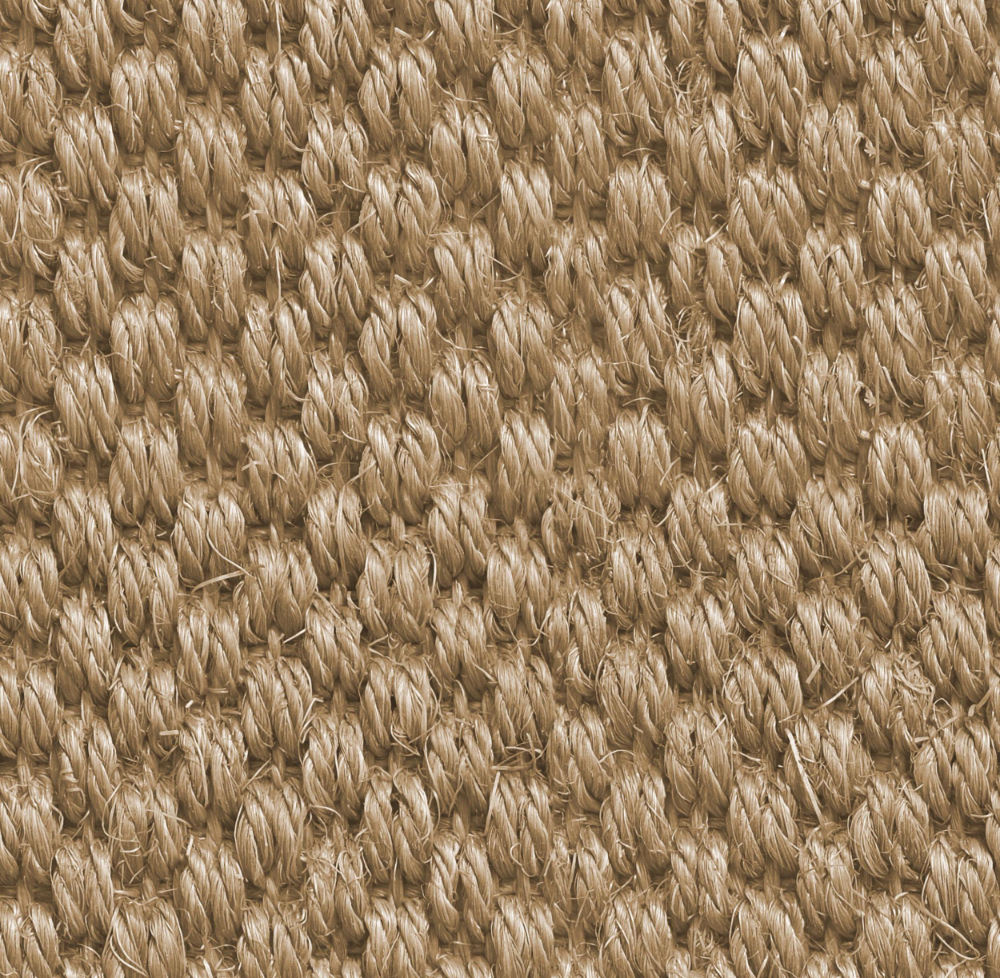Sisal Weave
Category
Fabric
Download
Edit
Sisal is a natural, plant based material which is woven using dried fibres from the harvested plant to create a strong, durable, moisture resistant fabric. The thick and heavy fibres are excellent for constructing heavy duty burlap sacks and bags for storing coffee, flour and foods such as potatoes and nuts, providing resistance to decay during transport and preventing moisture ingress while maintaining consistent conditions to preserve the contents during long periods of storage. While both jute and sisal are commonly used in the manufacture of burlap fabrics, it is coarser and stiffer than jute, meaning it is well suited to applications where a tougher surface is required, meaning it can also be used as the structure for baskets and objects through which other natural fibres such as willow, rattan and bamboo are woven. These characteristics have seen it rise to popularity with pet owners, as it provides a sufficiently durable, rough material for cats to scratch and maintain sharp, healthy claws without shredding or flaking the material. Besides this, sisal based fabrics are commonly utilised in matting, where its bristly fibres help remove dirt from shoes. It is also a popular choice for protective coverings over carpet and soft furniture, owing to its moisture resisting properties and tough, durable characteristics in the face of degradation, making it a particularly popular choice to protect old, thin or fragile carpets and fabrics from further wear and tear, particularly when an increased amount of foot traffic or visitors is envisaged.
Originating in the arid lands of southern Mexico, the plant has been naturalised in several other dry regions around the world such as Brazil, the Indonesian island of Java and central east African countries such as Tanzania, and is renowned for its hardy yet versatile fibres. The fibres are extracted through decortication, a process of stripping and crushing the leaves to leave only the fibres, before being dried, brushed and baled. Besides the aforementioned uses, low quality sisal fibres are often used to manufacture paper; medium quality fibres can be used to create water and salt resisting rope, twine and drainage fabric (geotextiles) for use in agricultural, construction and marine applications, as well as to manufacture cloths, macramé or dart boards; while high quality fibres are utilised in spa products, or spun as yarn to make hard wearing, low maintenance and dust impervious rugs and carpets. It is commonly woven to create a perfunctory, sturdy fabric which can be used for aprons, shopping bags, upholstering for chairs and sofas, or as screens, room dividers, hats, slippers and a multitude of domestic items such as dining placemats, baskets, storage crates, curtains or lamp shades. Sisal can also be woven to create pots for young plants as it holds soil and water well, while expanding to accommodate the growing roots, or used to create furniture such as outdoor seating, as it is sufficiently springy to sit comfortably on, often paired with a cushion, while being resistant to moisture and decay if treated correctly during manufacture. It can be dyed and woven into an array of finishing patterns, while remaining water tight and low maintenance. Its strength and flexibility mean it can be used to create durable fabrics with limited movement or differentiation under stress. By-products of sisal are used in the agricultural and pharmaceutical industries, while it can be consumed as an ingredient in street food or distilled to make Mezcal.
This sisal woven texture has an attractive natural, pale, straw-brown wash with a thick, curving weave where 4 strands are intertwined to create a warp, weaving in and out of a double strand weft. Sisal’s strong, durable characteristics and calm, airy, natural colouring make it popular for rugs and soft furniture coverings, although it can feel rather coarse, dry and irritating against skin. Sisal does however prove fairly resistant to spillages, stains, cleaning detergents and fluids when treated correctly. Overexposure to sunlight can cause some bleaching, meaning it shouldn’t be exposed to direct, sustained sunlight, requiring a gentle coated during the hand crafted manufacturing phase to prevent fading or bleaching. Sisal fabric is excellent for use in domestic, high traffic environments to create calm, relaxing, open feeling spaces, bringing a handcrafted, natural, biophilic touch to the rooms in which it is specified. The linear wave-like repetitions created by the rise and fall of the warp threads makes for a dynamic, riven appearance and feel, adding to its soothing appearance, with some signs of wear and tear in the loose, unwound or snapped strands.
A seamless fabric texture with a sisal weave surface. Seamless textures can be tiled repeatedly across a surface without visible seams making them useful for architectural drawings and 3D models. This image can be used as a SketchUp texture, Revit material or imported into Photoshop for use in 2D illustrations. A high resolution version of this texture is available, as well as CAD hatches and PBR maps with Architextures Pro.

